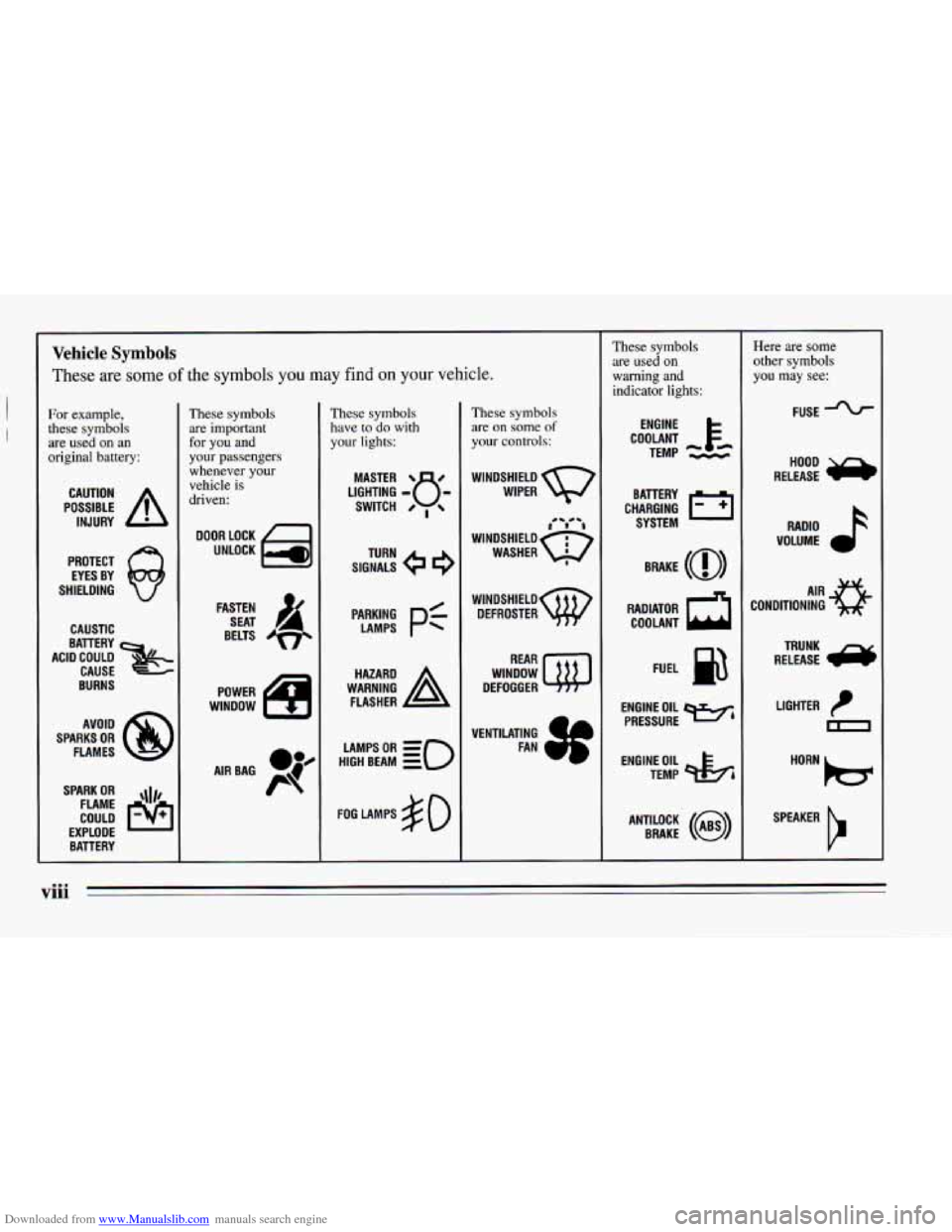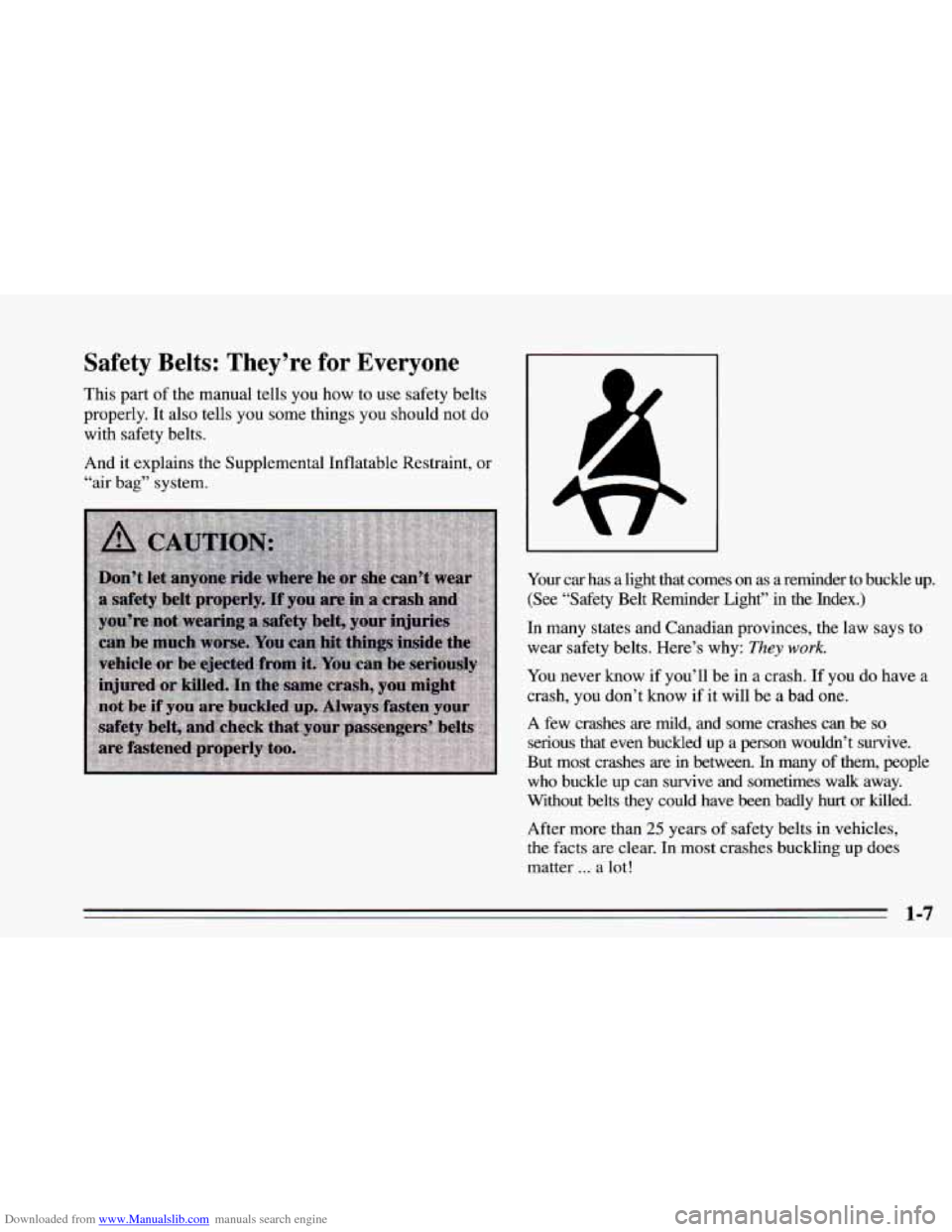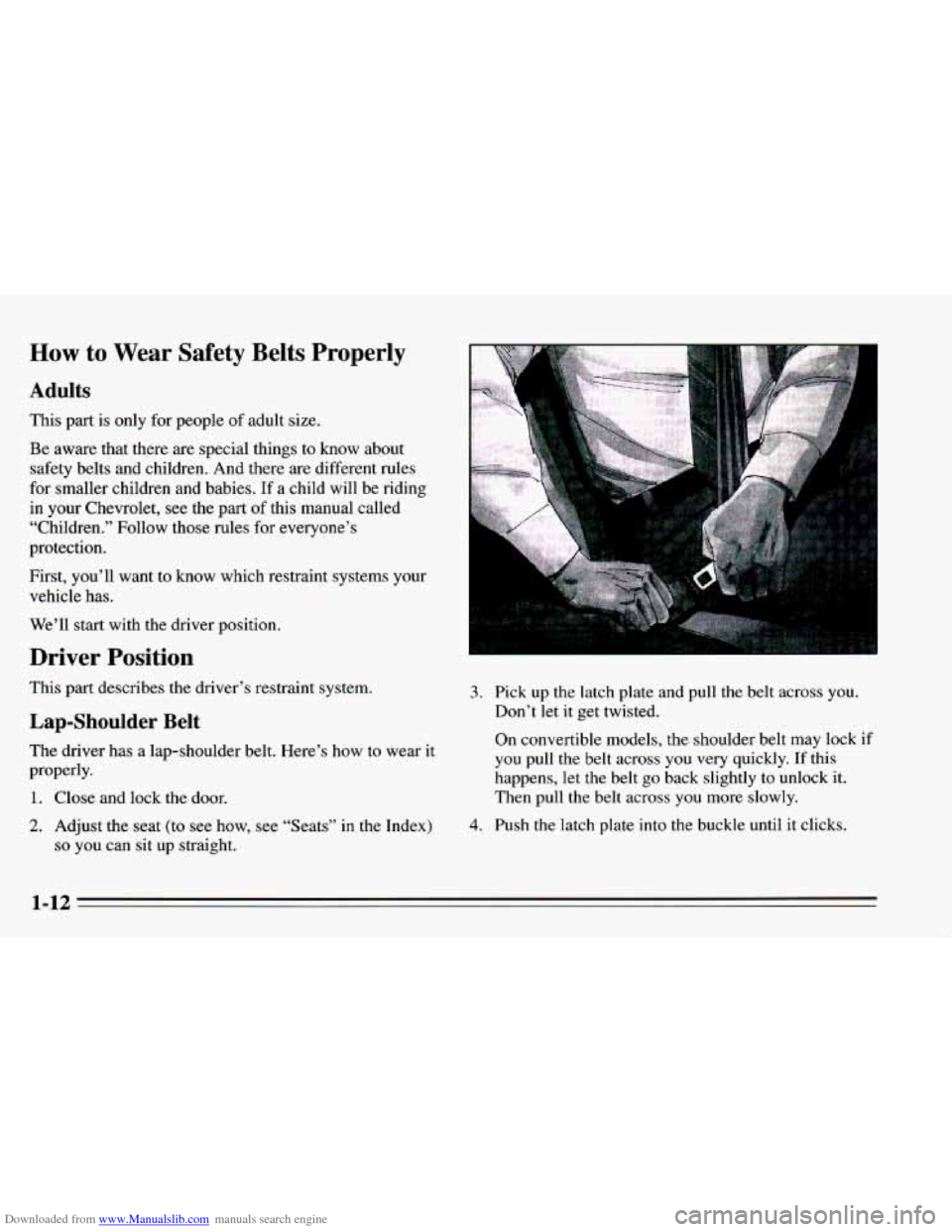Page 10 of 388

Downloaded from www.Manualslib.com manuals search engine Vehicle Symbols
These are some of the symbols you may find on your vehicle.
For example,
these symbols
are used
on an
original battery:
POSSIBLE A
CAUTION
INJURY
PROTECT EYES BY
SHIELDING
Q
CAUSTIC
ACID COULD
BATTERY
CAUSE
BURNS
AVOID
SPARKS
OR
FLAMES
SPARK
OR ,111,
COULD FLAME
EXPLODE BATTERY
These symbols
are important
for you and
your passengers
whenever your
vehicle
is
driven:
FASTEN SEAT 4
BELTS
POWER
WINDOW
These symbols
have to do with
your lights:
SIGNALS e
TURN
PARKING
PC
LAMPS
WARNING
A
HAZARD
FLASHER
These symbols are on
some of
your controls:
WINDSHIELD WIPER w
WINDsHIELDw DEFROSTER
WINDOW
DEFOGGER
VENTILATING FAN
HIGH BEAM =
FOG LAMPS $0
These symbols
are used
on
warning and
indicator lights:
COOLANT Fe
TEMP --
ENGINE
CHARGING
I-1
BATTERY SYSTEM
RADIATOR
a
COOLANT FUEL
ENGINE OIL
w,
PRESSURE
TEMP OIL
pk,
ANTILOCK (@)
BRAKE
Here are some
other symbols
you may see:
FUSE -%-
RADIO >
VOLUME
CONDITIONING RELEASE
e
TRUNK
LIGHTER
m
SPEAKER
b
viii
~
Page 17 of 388

Downloaded from www.Manualslib.com manuals search engine Safety Belts: They’re for Everyone
This part of the manual tells you how to use safety belts
properly. It also tells you some things
you should not do
with safety belts.
And it explains the Supplemental Inflatable Restraint, or
“air bag” system.
I
Your car has a light that comes on as a reminder to buckle up.
(See “Safety Belt Reminder Light” in the Index.)
In many states and Canadian provinces, the law
says to
wear safety belts. Here’s why:
They work.
You never know if you’ll be in a crash. If you do have a
crash, you don’t know if it will be a bad one.
A few crashes are mild, and some crashes
can be so
serious that even buckled up a person wouldn’t survive.
But most crashes are
in between. In many of them, people
who buckle up can survive and sometimes walk away.
Without belts they could have been badly hurt or
killed.
After more than 25 years of safety belts in vehicles,
the facts are clear. In most crashes buckling up does
matter
... a lot!
1-7
Page 22 of 388

Downloaded from www.Manualslib.com manuals search engine How to Wear Safety Belts Properly
Adults
This part is only for people of adult size.
Be aware that there are special things to know about
safety belts and children. And there are different rules
for smaller children and babies. If
a child will be riding
in your Chevrolet, see the part
of this manual called
“Children.” Follow those rules for everyone’s
protection.
First, you’ll want to know which restraint systems your
vehicle
has.
We’ll start with the driver position.
Driver Position
This part describes the driver’s restraint system.
Lap-Shoulder Belt
The driver has a lap-shoulder belt. Here’s how to wear it
properly.
1. Close and lock the door.
2. Adjust the seat (to see how, see “Seats” in the Index)
so you can sit up straight.
3. Pick up the latch plate and pull the belt across you.
Don’t let
it get twisted.
On convertible models, the shoulder belt may lock if
you pull the belt across you very quickly.
If this
happens, let the belt go back slightly to unlock it.
Then pull the belt across
you more slowly.
4. Push the latch plate into the buckle until it clicks.
1-12
Page 30 of 388
Downloaded from www.Manualslib.com manuals search engine AIR
BAG
There is an air bag readiness light on the instrument
panel, which shows “AIR
BAG’ on it. The system
checks the air bag’s electrical
system for malfunctions.
The light tells
you if there is an electrical problem. See
“Air Bag Readiness Light” in
the Index for more
information.
How the Air Bag System Works
I
I
1-20
Page 36 of 388
Downloaded from www.Manualslib.com manuals search engine .” ..
1. Pick up the latch plate and pull the belt across you.
Don’t let it get twisted.
On convertible models, the shoulder belt may lock if
you pull the belt across
you very quickly. If this
happens, let the belt go back slightly to unlock it.
Then pull the belt across you more slowly.
2. Push the latch plate into the buckle until it clicks. If
the belt stops before it reaches the buckle, tilt the
latch plate and keep pulling until you can buckle it.
Pull
up on the latch plate to make sure it is secure.
If the belt is not long enough, see “Safety Belt
Extender” at the end
of this section. Make sure the
release button
on the buckle is positioned so you
would be
able to unbuckle the safety belt quickly if
you ever had to.
1-26
Page 58 of 388

Downloaded from www.Manualslib.com manuals search engine Should interference to this system occur, try this:
0
0
0
0
Check to determine if battery replacement is
necessary. See the instructions on battery
replacement.
Check the distance. You may be too far from your
vehicle. This product has a maximum range.
Check the location. Other vehicles or objects may be
blocking the signal.
See your Chevrolet dealer or a qualified technician
for service.
Changes or modifications to this system
by other than an
authorized service facility could void authorization to
use this equipment.
Operation
The driver’s door will unlock automatically when
UNLOCK is pressed. If UNLOCK is pressed again
within five seconds, the passenger door will also unlock.
All doors will lock when
DOOR is pressed. The hatch
will unlock when
the opened trunk symbol is pressed,
but only when the ignition switch
is not in RUN, and the
transmission is in
PARK (P) if you have an automatic
transmission. If you have a manual transmission, the
parking brake must be set.
The system will turn on the interior lights for about
40 seconds, or until the ignition switch is turned to
RUN, when you unlock the doors or hatch. The interior
lamps
will come on for about two seconds when you
lock the doors.
2-6
Page 64 of 388
Downloaded from www.Manualslib.com manuals search engine Parking at Night
Park in a lighted spot, close all windows and lock your
vehicle. Remember to keep your valuables
out of sight.
Put
them in a storage area, or take them with you.
Parking Lots
If you park in a lot where someone will be watching
your vehicle, it’s best to lock it up and take your keys. \
But what if you
have to leave your ignition key? What if
you have to leave something valuable in your vehicle?
Put your valuables in a storage area, like your trunk
or glove box.
0 Lock the glove box.
0 Lock all the doors except the driver’s.
0 Then take the door key with you.
. ‘i
PASS-Key@II
Your vehicle is equipped with the PASS-Key%
(Personalized Automotive Security System)
theft-deterrent system. PASS-Key I1
is a passive
theft-deterrent system. It works when you insert or
remove the key from
the ignition. PASS-Key I1 uses a
resistor pellet
in the ignition key that matches a decoder
in your vehicle.
2-12
Page 65 of 388

Downloaded from www.Manualslib.com manuals search engine When the PASS-Key@II system senses that someone is using the wrong key, it shuts down the vehicle’s starter
and fuel systems. For about three minutes, the starter
won’t work and fuel won’t
go to the engine. If someone
tries to start your vehicle again or uses another key
during this time, the vehicle will not start. This
discourages someone from randomly trying different
keys with different resistor pellets in an attempt to make
a match.
The ignition key must be clean and dry before it’s
inserted in the ignition or the engine may not start. If the
engine does not start and the SECURITY light stays on
when you try to start the vehicle, the key may be dirty or
wet. Turn the ignition
off.
Clean and dry the key. Wait about three minutes and try
again. The security light will remain on during this time.
If the starter still won’t work, and the key appears to be
clean and
dry, wait about three minutes and try another
ignition key.
At this time, you may also want to check
the fuses (see “Fuses and Circuit Breakers” in the
Index).
If the starter won’t work with the other key, your vehicle
needs service.
If your vehicle does start, the first
ignition key may be faulty. See your Chevrolet dealer or
a locksmith who can service the PASS-Key’II.
If you accidentally use
a key that has a damaged or
missing resistor pellet, the starter won’t work and the
security light will flash. But you don’t have to wait three
minutes before trying another ignition key.
See your Chevrolet dealer or a locksmith who can
service the PASS-Key’II to have a new key made.
If you’re ever driving
and the “SECURITY” light comes
on and stays on, you will be able to restart your engine if
you turn it
off. Your PASS-Key@II system, however, is
not working properly and must be serviced by your
Chevrolet dealer. Your vehicle
is not protected by the
PASS-Key@II system.
If you lose or damage a PASS-Key’II ignition key, see
your Chevrolet dealer or a locksmith who can service
PASS-Key’II
to have a new key made. In an
emergency, call the Chevrolet Roadside Assistance
Program at 1-800-CHEV-USA
(1-800-243-8872).
2-13